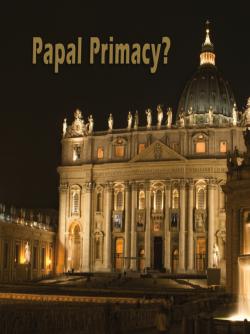The Sign of Jonah
Did you know that Jesus said there would be just one sign of His Messiahship? Shockingly, many today who call themselves Christians are involved in religious customs that actually deny this crucial sign! Could you be one of them?
Just what is the "sign of Jonah"? What does it have to do with you and your future?
"Show us a sign—then we'll believe you are the Messiah!" That was the challenge the religious leaders of His day issued to Jesus Christ. They wondered if this man was the Messiah, as some were claiming—and they demanded that He prove it!
What did He do? He did give them a sign, telling them: "A wicked and adulterous generation seeks after a sign, and no sign shall be given to it except the sign of the prophet Jonah" (Matthew 16:4). Another gospel account records these words of Jesus: "This is an evil generation. It seeks a sign, and no sign will be given to it except the sign of Jonah the prophet. For as Jonah became a sign to the Ninevites, so also the Son of Man will be to this generation" (Luke 11:29–30).
That sign, if we can identify it, will reveal the Savior of the world.
Christ's miracles were amazing signs of God's power and ministry. His works testified of Him (John 14:11). To the disciples of John the Baptist, Jesus showed signs of healing the blind and cleansing the lepers—which the Messiah was prophesied to do (Isaiah 61:1). Yet Christ said that the primary sign to identify Him as the Messiah would be "the sign of Jonah."
What was the sign of Jonah—and what does it have to do with us today?
A Call for Repentance?
"Some believe that the "sign of Jonah" was simply Jesus' call for those in His audience to repent—much as Jonah had also preached a call to repentance. Notice: "Now the word of the Lord came unto Jonah the son of Amittai, saying, Arise, go to Nineveh, that great city, and cry against it; for their wickedness is come up before me" (Jonah 1:1–2, KJV).
Later on in the account, we find what Jonah taught: "And Jonah began to enter into the city a day's journey, and he cried, and said, Yet forty days, and Nineveh shall be overthrown. So the people of Nineveh believed God, and proclaimed a fast, and put on sackcloth, from the greatest of them even to the least of them" (Jonah 3:4–5, KJV).
The inhabitants of Nineveh responded to Jonah's impassioned call to repentance. From the least to the greatest, all turned from their sinful lifestyle. "And God saw their works, that they turned from their evil way; and God repented of the evil, that he had said that he would do unto them; and he did it not" (Jonah 3:10, KJV).
Yes, both Jonah and Jesus preached about repentance. But was this the sign of which Jesus spoke? Or was there something else?
A Symbolic Resurrection?
"Some say the sign of Jonah was his symbolic resurrection from the dead, which foreshadowed Christ's resurrection. After all, when Jonah fled on a ship, was thrown overboard and was swallowed whole by a sea creature, he was as good as dead! We even have a record of his prayer—from inside the stomach of his captor! "Then Jonah prayed to the Lord his God from the fish's belly. And he said: 'I cried out to the Lord because of my affliction, and He answered me. Out of the belly of Sheol I cried, and You heard my voice'" (Jonah 2:1–2). The Hebrew sheol can also be translated as "the grave." Jonah knew that without God's dramatic intervention, his life would be over!
Yet God freed Jonah from his horrible underwater prison! In a sense, God brought Jonah back to life! Jonah described it: "For You cast me into the deep, into the heart of the seas, and the floods surrounded me; all Your billows and Your waves passed over me… The waters surrounded me, even to my soul; the deep closed around me; weeds were wrapped around my head. I went down to the moorings of the mountains; the earth with its bars closed behind me forever; yet You have brought up my life from the pit, O Lord, my God" (Jonah 2:3, 5–6).
Jonah was figuratively resurrected from the dead, much as Jesus Christ was literally resurrected from the grave. Is this the sign of which Jesus spoke? Or is it something else?
In Jesus' Own Words
"If we look carefully at Jesus' own words, we can see the key behind the sign of Jonah. "But He answered and said to them, 'An evil and adulterous generation seeks after a sign, and no sign will be given to it except the sign of the prophet Jonah. For as Jonah was three days and three nights in the belly of the great fish, so will the Son of Man be three days and three nights in the heart of the earth'" (Matthew 12:39–40).
Three days and three nights—this is the sign Jesus gave to establish His Messiahship. Our Savior staked His very identity on what some might brush off as a seemingly trivial detail!
But remember: our Creator is a God of perfect timing. He gave exact instructions for keeping the Passover on time (Exodus 12:12, 22). He gave human beings exact instructions for keeping a specific day of rest and worship (Exodus 20:8). He instructs us to observe specific annual Holy Days throughout the year (Leviticus 23). When it comes to prophecy, He has perfect timing, knowing the "end from the beginning" (Isaiah 46:10). Indeed, the prophet Daniel foretold the timing of Christ's first coming, hundreds of years in advance (Daniel 9:24–26). So we can understand that the death and resurrection of the Savior of the world would occur with perfect timing.
Did the Pharisees understand what Jesus was saying about His time in the grave? Of course! After His death, they came to Pilate with an unusual request. "On the next day, which followed the Day of Preparation, the chief priests and Pharisees gathered together to Pilate, saying, 'Sir, we remember, while He was still alive, how that deceiver said, "After three days I will rise"'" (Matthew 27:62–63).
The chief priests and Pharisees feared that Christ's disciples might try to fake His resurrection, following the exact timetable He gave, thus continuing His influence even after His death. In response, Pilate authorized additional security to make sure the grave was not tampered with (vv. 65–66).
Christ's audience understood the sign. But most did not want to believe it when Jesus was resurrected, and they did not accept Him as the Messiah.
Just "Parts" of Days?
Was Jesus really in the grave for three days and three nights? Why should we care? What difference does it make for us? Only that it was the very sign of His Messiahship! To reject it is to reject Him.
Yet there are hundreds of millions of well-meaning people today who observe "Good Friday" as the supposed day of Jesus' death, followed by "Easter Sunday" as the alleged day of His resurrection. But look carefully at the chart on the next page. From daylight Friday to daylight Sunday is only two nights and just parts of three days! There is no accurate way to interpret that time as the "three days and three nights" which Jesus gave as a sign!
Some scholars say that Christ's "three days and three nights" is just a linguistic idiom, rather than a precise expression of time. They claim that "three days and three nights" can refer to any portions of three days and three nights. For example, commentator Adam Clarke contends: "Three days and three nights, according to this Jewish method of reckoning, included any part of the first day; the whole of the following night; the next day and its night; and any part of the succeeding or third day" (Clarke's Commentary, Vol. V, p. 140).
Yes, there is one Jewish tradition of counting parts of days as a whole. As Clarke also explains: "The tradition is, that R. Eliazar ben Azariah said, 'A day and a night make an onah: and a part of an onah is as the whole'" (ibid.).
But if we dig deeper, we find that there are also other Jewish traditions for counting days. Some rabbis taught that an individual day or night—not only a combined day and night period—could be defined as an onah. Again, quoting Clarke: "How much is the space of an onah? R. Jochanan saith, Either a day or a night. And so also the Jerusalem Talmud: 'R. Akiba fixed a day for an onah, and a night for an onah'" (ibid.). By this tradition it would be just as accurate to interpret Jesus' statement as encompassing six onahs—parts or whole portions of three daylight periods and three night periods. Yet this would obviously not agree with the common understanding of a Friday crucifixion and Sunday resurrection.
What is the point? Because there are different uses of this idiom, we can draw drastically different conclusions depending on which tradition we follow. Therefore, Jewish tradition is not a reliable source for determining the length of time Jesus was in the grave.
But where can we look? Is there biblical evidence to determine the time Christ was in the grave? Yes, there is!
72 Literal Hours
"The book of Genesis gives us part of the answer. Reading about the first day of creation, we find "day" and "night" defined: "God called the light Day, and the darkness He called Night. So the evening and the morning were the first day" (Genesis 1:5). The word used here for "day" comes from the Hebrew word yowm, meaning "to be hot"—for the hours when the sun is up. The word for "night"—layil—comes from a Hebrew word meaning "away of the light," or the hours when the sun is down and it is dark (See Strong's Dictionary).
Significantly, when describing Jonah's ordeal in the belly of the fish, the book of Jonah uses the exact same words for day and night that are used in Genesis 1:5. "Now the Lord had prepared a great fish to swallow Jonah. And Jonah was in the belly of the fish three days [yowm] and three nights [layil]" (Jonah 1:17).
We can also observe how the New Testament uses the word "day." Notice Jesus' own words when He asked the question, "Are there not twelve hours in the day?" (John 11:9). Here, as in His words to the Pharisees, Christ considered "day" to be the approximately twelve-hour time period when the sun is up.
Some have been confused by the statement that Christ rose "on the third day" (Acts 10:40), thinking this must mean a period of fewer than 72 hours. Here, we need to remember to take into consideration the other Gospel accounts. For example, Jesus said, "Destroy this temple, and in three days I will raise it up" (John 2:19). We also find, "And He began to teach them that the Son of Man must suffer many things, and be rejected by the elders and chief priests and scribes, and be killed, and after three days rise again" (Mark 8:31).
The only way to satisfy all three conditions—on the third day, in three days, and after three days—is to pinpoint the time of Jesus' resurrection exactly at the precise end of a 72-hour period!
When did those 72 hours begin? Scripture shows that Jesus was crucified on a Preparation Day: "So when Jesus had received the sour wine, He said, 'It is finished!' And bowing His head, He gave up His spirit. Therefore, because it was the Preparation Day, that the bodies should not remain on the cross on the Sabbath (for that Sabbath was a high day), the Jews asked Pilate that their legs might be broken, and that they might be taken away" (John 19:30–31).
Readers sometimes assume that this Preparation Day must have been the Friday before a weekly Sabbath. But Scripture reveals that this Sabbath was in fact a "high day"—one of the annual Holy Days of Leviticus 23! Jesus was crucified after taking the Passover, as our Passover, then His body was taken to the tomb before the Holy Day known as the First Day of Unleavened Bread.
Does It Matter?
"Some of you reading this may be shocked to learn about timing you have never understood before.Others may ask, "What does it matter? Why worry about these technical details, when surely it is enough just to believe on Christ?"
Most professing Christians assume that Jesus Christ was resurrected on Sunday morning. Why? Because from childhood they were taught the "Easter story." But what does the Bible say? "Now on the first day of the week Mary Magdalene went to the tomb early, while it was still dark, and saw that the stone had been taken away from the tomb. Then she ran and came to Simon Peter, and to the other disciple, whom Jesus loved, and said to them, 'They have taken away the Lord out of the tomb, and we do not know where they have laid Him'" (John 20:1–2).
On the first day of the week, while it was yet dark, Mary Magdalene came, and Christ was already risen! Jesus Christ did not rise at sunrise. He rose before sunset on Saturday.
No, there was no "Easter sunrise service" in the early Church—even according to the Encyclopaedia Britannica: "The name Easter… is derived from Eostre, or Ostara, the Anglo-Saxon goddess of spring… There is no indication of the observance of the Easter festival in the New Testament." (1911 ed., p. 828).
So, where did the idea of a "sunrise service" come from? Amazingly, the Old Testament records God's people holding a "sunrise service" during a time of national apostasy and rebellion against Him! Notice what the prophet Ezekiel was inspired to write: "Then He said to me, 'Have you seen this, O son of man? Turn again, you will see greater abominations than these.' So He brought me into the inner court of the Lord's house; and there, at the door of the temple of the Lord, between the porch and the altar, were about twenty-five men with their backs toward the temple of the Lord and their faces toward the east, and they were worshiping the sun toward the east" (Ezekiel 8:15–16).
What were Israel's apostate priests doing? They were worshiping the sun, toward the east, following pagan rituals! Not only that, but the women were weeping for Tammuz. "And He said to me, 'Turn again, and you will see greater abominations that they are doing.' So He brought me to the door of the north gate of the Lord's house; and to my dismay, women were sitting there weeping for Tammuz" (Ezekiel 8:13–14). Tammuz was the Mesopotamian god of fertility, whose story of birth, death and resurrection each spring was said to symbolize the power of nature's renewal. The "Easter bunny" and the practice of coloring "Easter eggs" are modern descendants of ancient fertility rituals, having everything to do with pagan worship and nothing to do with the worship God ordained in Scripture! Easter worship is nothing but a counterfeit that does not worship the true Christ at all (Matthew 24:24)! For more information, write for your free copy of our booklet, Satan's Counterfeit Christianity.
Put simply, the Friday-Sunday story obscures and glosses over the true Holy Days of God, denies the sign Jesus Himself gave, and sets the stage for the introduction of pagan ritual in place of what God ordained. By contrast, the Bible's plain Wednesday-Saturday account, with Christ in the grave for the 72 hours He prophesied, fulfills the sign He gave, acknowledges the true Holy Days of God and reveals the Easter sunrise story as impossible and unbiblical!
So, what about you? Do you worship the God of the Bible? Or do you just follow man-made traditions, such as Easter—even when they contradict Scripture? Are you willing to challenge your beliefs when proven wrong by the Bible? We must not be like these vain worshipers whom Jesus described: "These people draw near to Me with their mouth, and honor Me with their lips, but their heart is far from Me. And in vain they worship Me, teaching as doctrines the commandments of men" (Matthew 15:8–9).
God does care how we worship Him (Deuteronomy 12:29–31). If we understand the sign of Jonah—which Jesus said was the only sign given of His Messiahship—we can begin to understand the true Jesus Christ of the Bible. When Jesus was raised from the dead after 72 hours in the grave, He fulfilled that sign. Do you accept His words that this was the sign of the true Messiah—which He gave to prove He is the Savior of the world?






